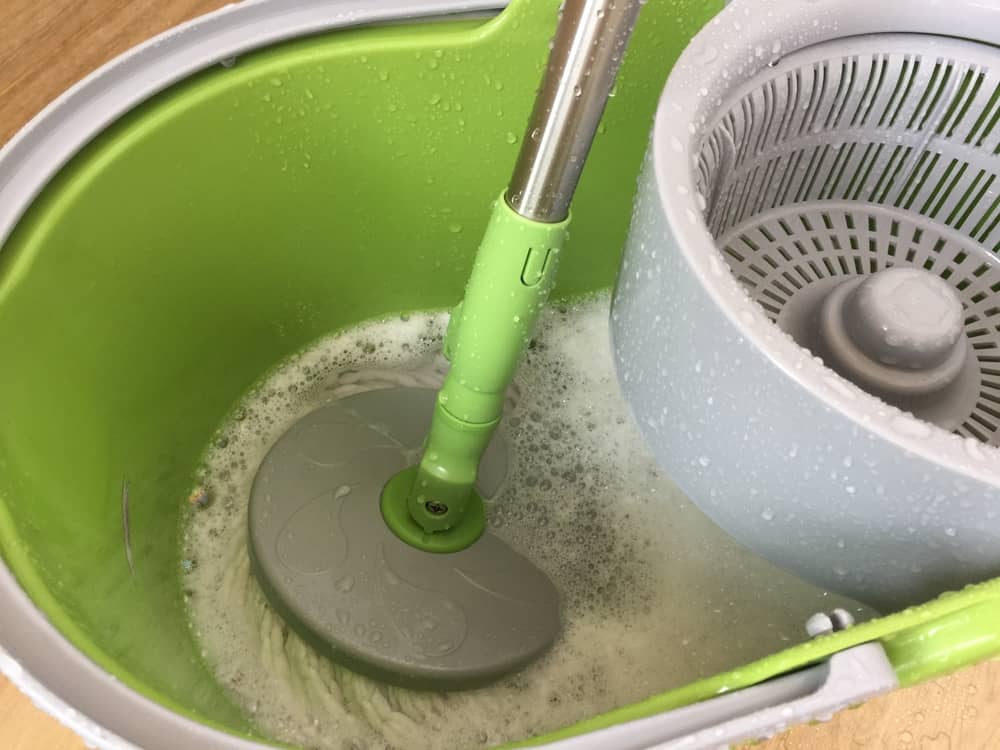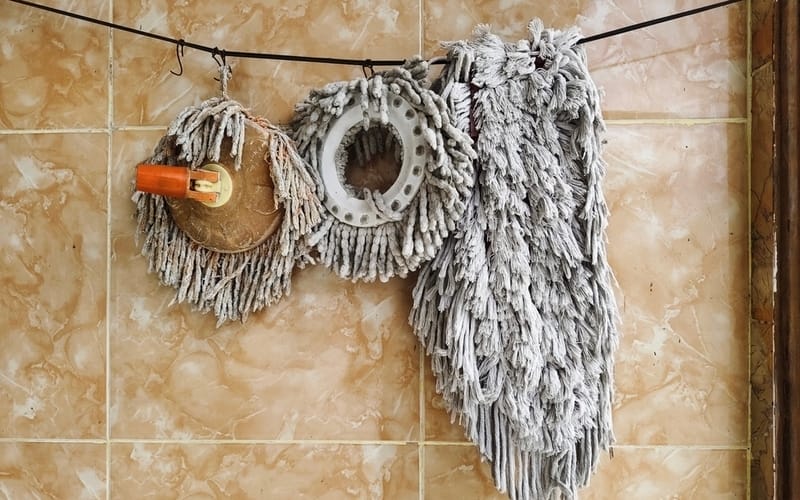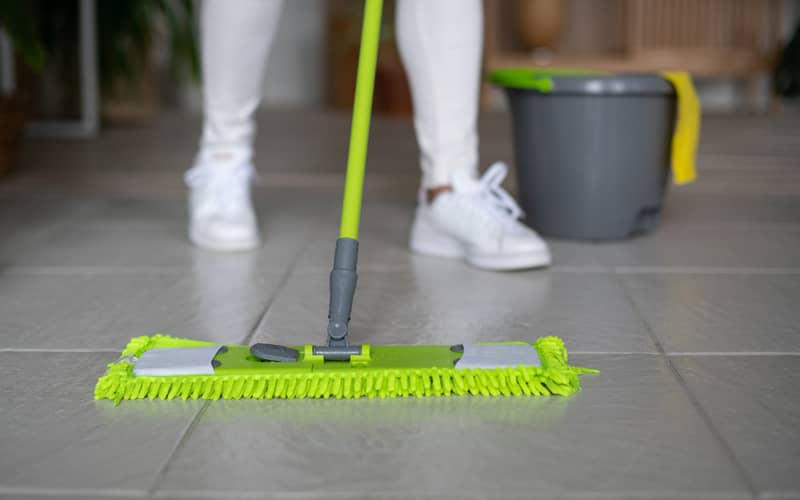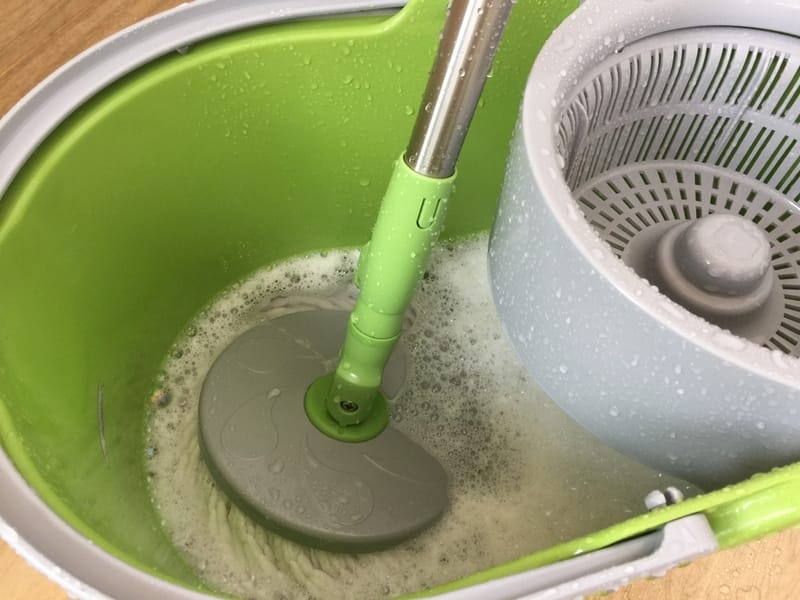Sure, cleaning your mop isn’t the most exciting chore in the world.
It’s still essential to keeping your house neat and tidy, though! A clean mop means you’re not tracking dirt all over your floors — and you’re not risking mould or bacteria growth.
Plus, cleaning your mop head regularly can help it last longer. It’s a little bit of effort for a little less waste in your home.
Removable mop heads can be cleaned in the washing machine, while fixed mops can be soaked in soapy water, then lathered or scrubbed. Rinse the mop thoroughly afterwards to remove any residue.
Keep your mop head in good condition — otherwise, you’ll be adding dirt to your floors instead of washing it away.
How Often to Clean | How to Clean | Cleaning Without a Washing Machine | Disinfecting | Drying | Cleaning the Mop Bucket | How Often to Replace
Mop Heads vs Mop Pads
Understanding the difference between a mop head and a mop pad will help with proper maintenance!
Both are typically washable, but are made of different materials with their own respective cleaning methods.
Mop head
Fixed mop heads are typically made from cotton, microfibre, or synthetic fibres. It’s designed to wipe away dirt and debris from your floors.
- Cotton mop heads: Consists of thick ropes of woven cotton, but not very absorbent
- Microfibre mop heads: More absorbent, so ideal for dry or wet mopping
- Synthetic mop heads: Less absorbent than microfibre, ideal for dry mopping
Since they’re fixed, these mop heads are best cleaned by soaking and some gentle scrubbing. Dry them upright, especially sponge mops, which could deform.
Mop pad
Mop pads are slightly different — these are flat, removable heads made of sponge or microfibre. They make mopping more efficient and provide an easy, hygienic solution for getting spotless floors.
The pads are designed to be easily removed, so you can switch to a clean one when the current pad gets too dirty. Most are washable, but disposable pads should be changed as recommended by the manufacturer.
For steam mops, you can clean the steam mop pad in the washing machine.
How Often Should You Wash a Mop Head?
It’s best to wash mop heads and buckets after every use! This removes odours and ensures you have a clean mop every time you use it.
Regular cleaning also removes any grime and bacteria the mop picked up during use, and minimises the risk of mould.
If you can’t wash the mop head right away, try to rinse it under running water. This still helps remove dirt and residue from the fibres after mopping.
Of course, you can skip the mop cleaning when you get a Maid2Match house cleaner to tackle your floors for you!
How to Machine Wash a Mop Head
Most of the time, you can machine wash detachable mop heads (or pads). Check the packaging or website to be sure.
To clean a mop, start by rinsing the fibres to remove loose dirt or debris. You can also fill a bucket with hot water and swirl the mop a few times.
Wring out the mop head, then toss it into the washing machine with some cleaning cloths or old towels. Try to use the same types of material — if you’ve got a microfibre mop, add microfibre cloths!
Add some liquid detergent and run a wash cycle. Avoid using bleach or fabric softener, which can damage the fibres or leave a residue.
Cotton mop heads can be washed in a hot water setting, while microfibre or sponge mops get a warm water setting.
After the rinse cycle, do not put the mop head in the dryer. Instead, wring out as much excess water as you can, then allow the mop to air dry.
Cleaning a Mop Head Without a Washing Machine
If your mop head isn’t machine washable or it’s fixed to the handle, you can still deep clean it by hand washing!
How to clean a dust mop
To keep your dry mop clean, start by removing dirt from the pad. Shake it out over the rubbish bin (similar to how you’d empty a vacuum canister).
Wash the mop head with warm water and a little dish soap. Use your hands (wear gloves!) to work the soap into the fibres and rub them clean.
Rinse off the soap, then let the mop air dry completely
How to clean fixed mop heads
Your cleaning method for a dirty mop head will depend on the type of mop!
You’ll have one of three types: string (cotton), flat (sponge), or microfibre.
- String mops: Hot water and mild detergent
- Flat mops: Warm water and dish soap
- Microfibre mops: Cool water and mild detergent
Fill a bucket with the cleaning solution, then plunge the mop head a few times before letting the mop soak for 5–10 minutes.
While wearing rubber gloves, wring and lather the fibres of the mop several times. You can also use a soft-bristled brush or sponge to gently scrub the mop fibres.
Rinse the mop head thoroughly under running water. Make sure all the soap is washed away, or your floor could get sticky after mopping next time.
How to clean removable mop heads
Start by rinsing the pad or head to remove debris and dirt from the fibres. Use a hose or faucet, or plunge the mop head into a bucket of clean water a few times, then wring it out.
For the cleaning solution, use a good laundry detergent or white vinegar. Just use one, not both!
To clean a mop head with vinegar, mix 1–2 cups in a bucket of hot water. Submerge the mop in the vinegar solution and leave it for at least 15 minutes.
For detergent, mix a small amount into a bucket of hot water and submerge the mop head for at least 15 minutes.
After soaking, scrub the fibres with a soft brush or sponge, or just use your hands (with gloves). You want to get rid of any remaining bits of dirt so they don’t transfer back to your floors.
Rinse the mop head thoroughly, then wring it out.
How to Disinfect a Mop
Once a week — or at least once every few weeks — it’s good to disinfect your mop head.
The fibres see a lot of dirt and bacteria from your floors, so you want to keep your mop head clean.
Soak the mop head in one of the following solutions. Only use one and never mix them!
- Diluted laundry sanitiser in cool water
- 1 cup white vinegar in a bucket of hot water
- 1/4 cup hydrogen peroxide per 1 litre of warm water
Leave the mop head to soak for at least 10 minutes, then rinse it well in running water. Wring out the fibres before allowing the mop to air dry.
How to Dry a Mop
After washing, all you need to do is let the mop head air dry!
Start by wringing out as much excess water as you can. This can help shorten the drying process and reduce the risk of mould or unpleasant odours.
For fixed mops, place them upright outdoors or in a well-ventilated area for a few hours so they dry completely. Avoid direct sunlight, which could cause wear or discolouration, especially for microfibre.
For removable mop pads, lay them flat on an old towel in a well-ventilated space. This helps the pad keep its shape while drying.
How to Clean a Mop Bucket
After you’ve finished mopping, empty the dirty water from the bucket, then give it a good wash with hot water and dish soap.
Wipe it dry with a soft cloth. For spin mop buckets, it may be hard to access the bottom parts, so wipe as much as you can before letting the bucket air dry.
To disinfect your mop bucket, fill it with hot water then add 2 cups of white vinegar. Let the solution sit for 15 minutes before emptying the bucket, then rinse and dry.
How Often Should You Replace Your Mop?
Even good-quality mops will wear out over time and with prolonged use. Mop heads need replacing the most often, but even handles and buckets can wear out.
How you mop and how often can also affect the wear and tear. Here are some useful general rules to follow:
- Sponge mops: Every 1–3 months
- Fixed mop heads: Every 2–4 months (used daily) or 4–6 months (used weekly)
- Reusable mop pads: Every 6–12 months
- Disposable mop pads: Every 1–3 months
However, if you notice any damage or stubborn stains, or the mop head stays dirty even after cleaning, it’s best to replace it ASAP.
For mop handles, these shouldn’t need replacing unless they’re broken or won’t stay attached to the mop pad/head.
The same goes for buckets — if you notice cracks or leaks, or the spinning mechanism doesn’t work, time to get a new one! Otherwise, a good mop bucket can last for years.
FAQs: More About Mop Heads
Here are a few more tips and common concerns when cleaning mop heads.
What is the best way to clean a dirty mop head?
If your mop head or pad is machine washable, that’s usually the best cleaning process! Your washer will get most of the dirt and debris out.
Otherwise, soaking then hand washing works just fine.
How to clean mop heads without bleach or vinegar?
It’s easy to clean a mop head with no chlorine bleach or vinegar — a heavy-duty detergent will do the trick! This applies to both machine and hand washing.
Moreover, it’s best not to use chlorine bleach on a mop, especially for microfibre or sponge, since bleach can degrade the material.
How do you get a dirty mop white again?
If your mop head is looking grey or dingy, you can get it white again with a good soak using one of the following:
- 1 cup vinegar
- 1/4 cup hydrogen peroxide
- OxiClean (follow package instructions)
Add your chosen cleaner into a bucket of water, then leave the mop head to soak for several hours. Rinse the mop thoroughly afterwards.
Never mix any of these products, as that can create toxic reactions.




